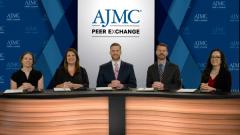
Trajectory of the HIV Treatment Landscape
The panel of experts discusses emerging and anticipated changes to the HIV treatment landscape.
Episodes in this series

Adam C. Welch, PharmD, MBA: Let’s speculate for a moment. Where do you see the landscape of HIV care—from a medication, treatment, or even prevention standpoint—in the next 5 years?
Ann Khalsa, MD, MSEd, FAAFP, AAHIVS: I’m excited about better-tolerated medications and hopefully more injectables or implantables. If I could do a Norplant-type implantable device that was a complete regimen, that lasted 6 months, 12 months, a couple of years, that would be phenomenal. We already have highly effective meds. There will probably be some new classes [of drugs], some new formulations. Hopefully, we’ll get down to longer acting, and it won’t be a daily pill, but it will still be a daily pill for lots of patients. Socially and politically—I guess I’m too old and too skeptical—will we as a society do what needs to be done to address this? If we do, we’ll also be addressing poverty, racial discrimination, and health care inequity. Do we have the political will and ability to overcome our differences to get there? I don’t know. We need to. That’s been 1 of my passions about working in HIV. If we could effectively get the epidemic under control, we would have to address those. We’re passionate about it and hope that we can get there, but it’s going to take a lot more dialoguing and networking.
Christian B. Ramers, MD, MPH, FIDSA, AAHIVS: It’s easy to get enamored by all the shiny new toys, and the therapeutics are going there. It would be great for prevention as well. An implantable prevention tool that made somebody uninfectable with HIV would be a nice innovation. But taking things back to low-tech solutions, think about the Ryan White [HIV/AIDS] Program. It’s a low-tech idea that you have to take somebody and wrap services around them for them to achieve that virological suppression. We can do that. Payers can learn from Ryan White that the social determinants of health are critical to getting people to their health goals. That’s an easy thing that we could do right now.
Ann Khalsa, MD, MSEd, FAAFP, AAHIVS: Part of that is that there has to be payment behind that. It’s legislated from Congress on down that we, as health care providers, attend to the social determinants of health. It’s a care gap metric that I have to click off in my electronic medical record. That frustrates me, not because it’s not important but because I have no resources to address them with. I can diagnose them. That’s not the solution. Give me the resources to get these needs met. That’s the frustrating piece. Too many individuals who write the regulations don’t realize how hard it is for those who are struggling in this vicious circle of homelessness and poverty. They can’t just pull themselves up by their bootstraps. They’ve got to be given a leg up to get there, to get out of that cycle. I haven’t seen the political will to uniformly get those needs met.
Shauna Applin, ARNP, CNM, AAHIVS: Christian mentioned that when he was talking to a patient to strategize their regimen, this is a human sitting in front of us. That can’t be forgotten. What’s coming in the future could be the shiny thing. It could be the old standby. But what’s the best thing for the patient? What do they find tolerable, and what are they willing to do? That’s critical. If individuals are legislating or putting together programs and forgetting that this is a real person in front of us—a real person needing holistic wraparound services for their lifetime—then we’re forgetting that central to each decision is an individual whose life is affected.
Alina Orozco, RN: Having worked in managed care for over 10 years and having come from the Ryan White side, I’m encouraged that we see contractually for our plan in Medicaid in Florida that we have to address the social determinants of health. We have to have benefits in place. We have to collect data. That’s a shift that we’ve seen and we continue to see. I’m hopeful it will continue because it makes sense for everybody
Transcript edited for clarity.
Newsletter
Stay ahead of policy, cost, and value—subscribe to AJMC for expert insights at the intersection of clinical care and health economics.






























































